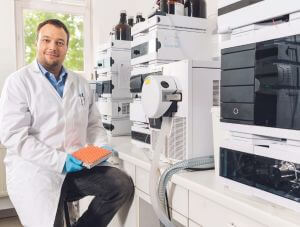Microplastics, macro problem

Microplastics, tiny fragments of plastic, are the latest – and possibly the biggest - emerging environmental contaminant to impact the Earth. In this article, we explain how they have been found in every ecosystem on our planet, and are threatening to colonise our food, water, and even our bodies. We examine the uncertainty about how plastic particles affect human health, and the lack of microplastic testing methods and regulation. But we save the good news to last: a groundbreaking new range of microplastic reference materials from LGC Dr Ehrenstorfer that could help scientists to develop new microplastic regulations, research studies and analytical methods which safeguard environmental and human health.
What are microplastics?
The US Environmental Protection Agency (EPA) definition of microplastics characterises them as plastic particles ranging in size from five millimetres (5,000 microns) to one nanometre (or a thousandth of a micron). Nanoplastics, a subset of microplastics that are all invisible to the naked eye, are defined as being smaller than one micron. The EPA also identifies two microplastics categories: primary microplastics, which are intentionally manufactured for use in consumer products (including cosmetics or biomedical products), and secondary microplastics, a term for plastic particles that have broken down from larger plastic materials (such as synthetic textiles and food wrapping).
Microplastics are everywhere
Mass production of plastics began in the 1940s and 1950s and - because of their versatility, practicality, strength, durability, and low cost – growth in the use of plastics globally has since exceeded that of any other material. As one research paper puts it, “In just a few decades, plastic has invaded our lives (and) as a result, plastic waste accumulates in all environmental matrices and contaminates them... over the whole planet.” The EPA adds that “Microplastics have been found in every ecosystem... from the Antarctic tundra to tropical coral reefs, (as well as) food, beverages, and human and animal tissue.” The potential impact of this accumulated plastic pollution has now been recognised as an emerging environmental issue. On current forecasts, around 12,000 megatons of plastic will be dispersed around the world by 2050.
Sources of microplastic pollution
Unsurprisingly, human activity is the primary cause of microplastic contamination, exacerbated by widespread failings in plastic waste management. A 2024 study of microplastics in China’s Wei River concluded that “microplastic abundance... was related to anthropogenic activities (population density, per capita GDP and distance),” combined with environmental factors such as water temperature.

Household microplastic pollution results mainly from the use of products containing microplastics, including personal care items, as well as clothing fibres released during laundry. Research by the US National Institute of Standards and Technology (NIST) also demonstrated that, when ultrapure water heated to 100°C was placed for 20 minutes in a takeaway beverage cup lined with low-density polyethylene (LDPE), it released a trillion plastic nanoparticles per litre. Meanwhile, testing in the US on more than 250 plastic water bottles revealed “widespread contamination with plastic debris” including polypropylene, nylon, and polyethylene terephthalate (PET). On average, this amounted to 10.4 plastic particles measuring around 100 microns in each litre, together with 314.6 smaller particles that were also thought to be plastic.
Plastic is also used widely in agriculture: for example, in controlled release fertilisers, containers, pipes, bags, and films for greenhouses and mulching. The spreading of microplastic-containing sludge from wastewater treatment plants onto fields is another major contamination route – according to one estimate adding up to 430,000 tons of microplastics to European agricultural land each year. Finally, nanoplastics generated by the degradation of vehicle tyres also add significantly to the mix of plastic pollutants – falling in plastic-contaminated rain all over the world and potentially contaminating food supplies (see below).
The environmental and human health effects of microplastics
The overarching problem with so many plastic pollutants escaping into the wider environment is that microplastics become a potential risk, not only to ecosystems, but also to humans, “since they can be bioaccumulated through the trophic chain.” Although water treatment works can remove up to 90% of microplastics contained in waste water, large quantities still manage to get into rivers and oceans. Once they have contaminated animal habitats, “microplastics... get eaten by fish and other sea animals (and) humans get exposed to microplastics when consuming polluted seafood, such as mussels or oysters.”
On land, meanwhile, microplastics from vehicle tyres, sewage sludge and other sources “could be taken up by edible plants, leading to human exposure” - as was shown last year by an Austrian study that found 16 tyre-derived compounds in 28 commercial leafy vegetable samples grown in four different countries. The presence of microplastics has additionally been confirmed in honey, sugar, sea salt, and tap water - but plastic pollution could also pose a much wider threat to our food security and biodiversity, as evidence is now emerging that microplastics may be damaging the ability of plants to photosynthesise.
Let's turn the tide on microplastics together
If you're tackling this issue, we want to hear from you and explore how we can support your microplastics research. Complete this short survey and we'll be in touch! |
Are microplastics in human bodies harmful?
In 2022, scientists announced they had found tiny plastic particles in living humans - in donated blood samples, and deep in the lungs of surgical patients. The same year, microplastics were also found in 75% of breast milk samples from 34 mothers in Rome, a week after they gave birth. In 2024, microplastics (chiefly polyethylene) were detected in each of 62 human placenta samples tested in an American study, raising questions about their potential impacts on developing foetuses. Suspicions also emerged about a potential link between microplastics and erectile dysfunction after particles were discovered in penises for the first time – amongst a cohort of men being treated for the condition. Similarly, the presence of microplastics in human and dog testicles in another study last year suggested that research could be needed into whether plastic particles are a contributory factor in declining sperm counts.
Despite these questions, there is little clear evidence so far that ingesting plastic particles is in itself dangerous to human health. Christopher Zangmeister, a researcher involved in the NIST plastic cup study, argues that exposure to so many small particles is “a big deal, because they could get inside of a cell, possibly disrupting its function.” Dick Vethaak, the Dutch ecotoxicology professor who co-discovered the plastic particles in human blood, says more research is needed on whether micro- and nanoplastics might overwhelm human bodies that are already coping with dust, pollen and soot every day. “We live in a multi-particle world,” Vethaak told National Geographic in 2023. “The trick is to figure out how much plastics contribute to that particle burden and what does that mean.”
When considering human health risks from microplastics, is it also important not just to assess the particles themselves, but the potential toxins they bring along with them. These include chemicals added to plastics to improve their appearance and performance, many of which are now proven to be harmful. Last year, a world-first umbrella study from Australia described by its authors as “a red flag for the world” found that exposure to chemicals found in common plastics – including bisphenol A (BPA), polychlorinated biphenyls (PCBs), polybrominated diphenyl ethers (PBDEs) and polyfluoroalkyl substances (PFAS) - could increase health risks at all stages of life. Among the adverse conditions linked to plastic chemicals by the report were risk of miscarriage, low birth weight, obesity, endometriosis, type 2 diabetes and cardiovascular disease.
Can better reference materials deliver better microplastic testing and regulation
Regulation of microplastics, as distinct from broader efforts to tackle overall plastic pollution, is still very much in its infancy. Perhaps the sole global success so far has been the widespread banning of microbeads – a type of microplastic used to exfoliate the skin – starting in the Netherlands in 2014, and with the US, UK, China, Japan, Australia and New Zealand all since following suit.
The European Union’s so-called “glitter ban” – an attempt to stop the release of around half a million tonnes of intentionally added microplastics – came into effect in September 2023, and almost immediately outlawed glitter powder and loose plastic glitter used for arts, crafts and play. The same legislation also brought in plans to phase out a number of other products – including glittery rinse on- and off cosmetics, make-up, lip and nail products – between 2026 and 2035. The European Chemicals Agency (ECHA) has also recently consulted on its plans to impose reporting obligations on manufacturers who are still permitted to use microplastics, with the aim of improving microplastic monitoring and risk assessment.
Microplastics testing, meanwhile, is similarly underdeveloped: the EPA commenting that “The wide range of particle sizes, densities, and compositions pose a challenge for researchers because there is not a single method that can be used to characterise the wide variety of micro and nanoplastic particles."
The EPA also identifies “a pressing need to develop and standardise collection, extraction, quantification and identification methods for micro and nanoplastics to improve reliability, consistency, and comparability across studies.” Furthermore, it adds that new methods are required for a wide range of media – including sediment, surface water, and aquatic species.
To date, one of the main obstacles to developing testing methods for microplastics has been the lack of high-quality microplastic reference materials. Without being able to reliably characterise the microplastic substances they are studying, it is next to impossible for researchers and analytical scientists to arrive at consistent and unified ways of working – and for regulators to develop meaningful guidelines. The good news, however, is that LGC Standards has taken a major step towards resolving that problem...
INTRODUCING....
Game-changing new microplastic reference materials from LGC Standards!
LGC Dr Ehrenstorfer now offers a groundbreaking range of microplastic reference materials to enhance and support your environmental research, method development, and testing.
Certified to ISO/IEC 17025, and accompanied by comprehensive Certificates of Analysis, the new range features the most common microplastics encountered in analysis: polyethylene (PE) and polypropylene (PP), plus nylon (N66) and polyester (PET) fibres.
The new standards are expertly designed to bring seamless harmonisation across microplastics testing – whilst also addressing future regulation and empowering you to stay ahead, drive innovation, and confidently meet emerging regulatory standards.
Our PE and PP microplastics standards are both available in five different particle sizes, with one size each for the N66 and PET versions. All are provided in a 50mg pack size to meet your requirements.
Provided as pure polymers with specific particle size distribution, the new range makes possible:
LGC Standards is unique in offering both fibres and spherical particles, meaning that you can test a full range of microplastics at once – not only improving your productivity and profitability, but also establishing a positive, forward-facing reputation for your laboratory as it works towards better consumer and environmental safety.
The jet milling technique we’ve used to manufacture our new reference materials also enables us to provide highly accurate particle size counts for PE and PP – saving you money on expensive equipment and internal standard preparation, and giving you even more confidence that your results are error- and bias-free.
|
Get more from LGC Standards



